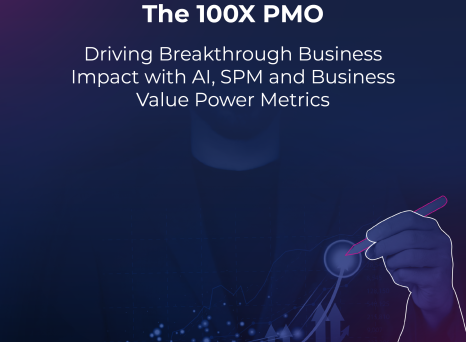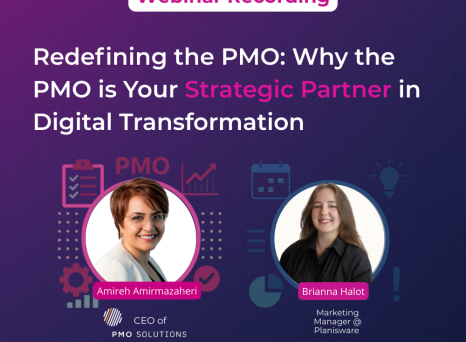One of the key missions of the Project Management Office (PMO) is to standardize and optimize a company's project portfolio. Now with more available solutions and tools combined with the move towards more extensive digitalization and integration, the classic PMO is transforming into the Digital PMO.
We spoke to Rich Weller, MI-GSO | PCUBED consultant, and discovered how the Digital PMO can direct a total change and lead the change towards digitalization.
What is a Digital PMO?
The Digital PMO is the natural evolution of the PMO in a world where digitization is the key to a company surviving and thriving. It is a PMO who has made the conscious decision to become an internal leader who discovers, vets, and leads the adoption of technology in all things project and. They see the question of how to leverage technology to bring a data-driven perspective to projects and portfolios across all departments as essential to the overall PMO mission.
Instead of searching for smaller incremental improvements, the Digital PMO creates a large internal shift, focused on leveraging technology, to set foundations for future projects and milestones.
One of the major tasks of the Digital PMO is to discover solutions that remove repetitious manual processes and replaces them with automation through technology. This change enables teams to move more efficiently and reduce operational costs. The Digital PMO will also use data from these tools to create strategies against future needs.
How does a switch to a Digital PMO affect your business?
Digital PMOs can have different impact depending on where they sit within the organization. An enterprise PMO working next to executives could project manage at a high level. The departmental PMO may be directly managing processes and procedures with a specific team. Regardless of placement, the Digital PMO should have the same goal.
Digital transformation doesn't mean only a specific number of tools or procedures are adopted and integrated. A full digital transformation takes a 40,000 ft high organization view and audits existing tools and solutions down to every single process that links a project from start to finish.
When the Digital PMO starts to design a plan towards full digitalization, they must understand the current state of the company. Taking stock of existing technologies and platforms, the Digital PMO can gauge and plan out the necessary steps to improve or replace internal technologies that adopt the latest project portfolio management features and data security practices.
Companies might use Zoom, Microsoft Teams, Google Meet, or even a combination of communication platforms. But that's only the beginning. The Digital PMO will examine how tools are used and the processes to move data from one project milestone forward.
To improve processes, the Digital PMO analyzes institutional practices and reveals areas where improvement is achievable. Ultimately, technology should enable the entire company to collaborate without regard to a physical working location.
When the Digital PMO completes a plan to move towards a new digitally focused process or technology, they need to meet with key decision-makers to create an agreed-on roadmap. It's even more important that stakeholders fully understand the who, what, and why of this change. To have a full digital transformation, a lip service agreement will only negatively affect the process in the future.
How the Digital PMO Will Lead Change
The Digital PMO is the champion for digital change. They aren't only selecting the most cost-effective tool to replace an aging analog system. The Digital PMO will research and analyze solutions that will have the most impact and ROI from both a short-term and long-term analysis. Integrating a new solution requires more than a budget investment. It goes further to include potentially reimagine processes to increase efficiency in workflows.
Data should inform and instruct many strategic decisions in project management. Any data input needs to be clean and error-free. Having purpose-built tools can minimize data issues if APIs are developed correctly and communicate properly with other solutions. Single-use tools are perfectly capable of being used within a technology stack if data is transferred into a solution that offers a single source of data truth.
Ideally, project teams should not be locally storing data. Everything should be input into shared databases. Within those tools, automated processes will verify and transfer information to produce accurate reporting reflected in timeline dashboards, reports, and statuses.
Then as more projects are completed within this digital work structure, trends can be extrapolated that Digital PMOs can use to forecast future project needs. The core of the Digital PMO, according to Rich, is that the “classic PMO looks in the past” while the “Digital PMO looks towards the future.”
The Digital PMO is the Digital Transformation Leader
When processes “work” well enough to keep a business running, there isn't a rush to make a change. But a Digital PMO is the catalyst to transform a company to adopt a new strategic structure that's data-driven in strategy and planning. Using technology that harnesses the strength of cloud-based solutions to minimize silos, and enabling projecting tools like automation and machine learning to continually improve the processes and techniques, they help bring projects from ideation to market faster and more effectively.
If a company is still using discrete and siloed solutions, manually importing and exporting data, and spending hours compiling reports, that's a sign that change is needed. The investment might appear large, but the businesses will improve across all areas of their project portfolios.
Learn even more about the Digital PMO from our Transforming to a Digital PMO webinar. In it, you will learn about the value of a Digital PMO, the necessary framework to evolve into maturity, and helpful guidance to get started on the Digital PMO journey.


